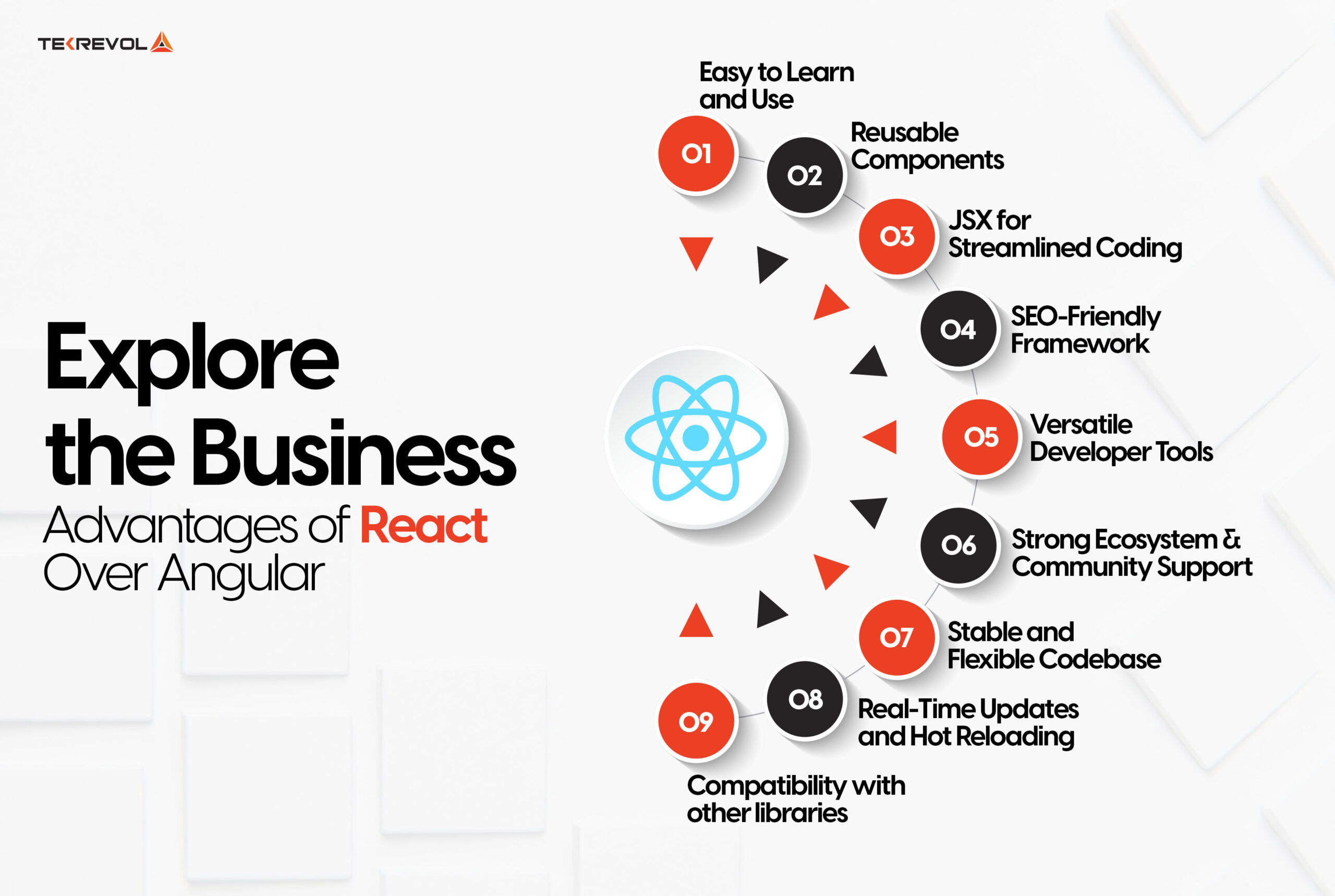When it comes to building powerful, scalable web applications, the debate between Angular vs React is still relevant in 2025, and the numbers prove it. In the latest Stack Overflow Developer Survey, React is used by 42.87% of developers, while Angular is used by 17.46%.
Despite React’s lead in popularity, both tools serve different needs, and choosing the wrong one can slow down your development cycle or inflate long-term costs.
If you’re building a highly structured, scalable enterprise application, Angular’s all-in-one framework might be a better fit. For lean, fast, and flexible UI development, React offers more freedom and a lighter learning curve. Your choice should reflect your project’s size, timeline, and team skills.
This comparison breaks down Angular and React across performance, scalability, learning curve, and real-world use. You’ll get direct answers, data, and examples to help you choose the right front-end framework for your next app.
- Unsure framework for your app?
- Our front-end specialists can guide your decision and bring your vision to life.
- Get In Touch Now!
What is Angular?
Angular is a full-fledged front-end framework developed by Google for large-scale, structured web applications.
It follows the MVC (Model-View-Controller) pattern and uses TypeScript, offering static typing and enterprise-grade scalability. This makes it ideal for apps where structure, consistency, and long-term maintenance are critical.
Google, Microsoft, and Deutsche Bank use Angular for large internal and customer-facing platforms.
“Angular’s opinionated structure is great for teams that value consistency and long-term scalability.” Minko Gechev, Angular Team Lead at Google
Key Features of Angular
Angular comes with everything out of the box—routing, form handling, HTTP services, testing utilities, and more. Here’s what sets it apart.
1. Full-fledged Framework
Angular is not only a library but also a complete framework that offers programmers a powerful and effective environment for implementing their applications. For routing, state management, and form handling, Angular provides all the functionalities that can be used directly without depending heavily on third-party libraries.
2. TypeScript for Enhanced Development
TypeScript, an advancement of JavaScript, provides static typing and enhanced tooling. Using TypeScript allows developers to rectify issues earlier in the development process and makes the code more dependable.
3. Two-Way Data Binding
Two-way data binding, which guarantees that the data model and the user interface remain in sync, is another crucial aspect of Angular. This implies that any modification to the data model automatically affects the view and vice versa.
Not only does this make the process easier from the coding point of view, but it also eliminates the need to write similar code repetitively.
4. Component-Based Architecture
Angular separates apps based on reusable components. This method of creating code in modules makes it easier to maintain, reuse, and test while the application is still growing.
5. Dependency Injection
The dependency injection philosophy used by Angular makes it easier to maintain and share the code within an application. To organize dependencies whenever they are required, Angular eliminates the involvement of code extraneous to the testing environment, thus making code organized, less complex, and more manageable.
6. Powerful CLI
Angular includes a Command Line Interface (CLI) with numerous commands that make development work easier. From component creation to build optimization, the Angular CLI boosts productivity and produces projects that follow best practices.
What Are the Major Business Advantages of Angular Over React?

The selection of the right framework to support the application development plays a significant role in the success of a business. Angular is a powerful tool that is characterized by numerous advantages that erupt to improve various aspects of development and quality of applications. Now let’s discuss the most important benefits of using Angular.
1. Effective Cross-Platform Development
Angular makes cross-platform development easier by allowing teams to use a single codebase for both web and mobile apps. This speeds up time-to-market, cuts down on development costs, and ensures consistent user experiences across devices and operating systems. As a result, businesses can reach a wider audience without doubling their engineering efforts.
2. High Quality of the Application
Angular enables the production of high-quality apps thanks to the components’ clean and well-structured code, making it simple to maintain and deploy updates. This will save the developers a significant amount of time, allowing them to focus on improving the product.
3. Improved Speed and Performance
Angular scored highly in the speed and performance aspects. Its efficient tools make the development process easier by allowing you to build applications in record time and get items to market faster. Additionally, Angular includes several upgraded capabilities that improve the loading time and response time to user inputs, such as lazy loading and ahead-of-time compilation.
4. Real-Time Synchronization with Two-Way Data Binding
The two-way data binding feature in Angular enables the copying of data from Model to View and vice versa by default. Whenever data is entered in one part, it simultaneously changes in the other, which means that the development process is less likely to be slowed down by the need to make changes. The real-time updating of the application makes Angular highly efficient in saving time and effort for a developer.
5. Efficient Server Communication & Faster API Responses
Angular improves server interaction via caching and creating static files that do not require CPU, making response times to API calls significantly faster. Angular.js helps much in creating modern applications because it allows DOM elements for user interaction without the need to refresh the whole page.
6. Built-In Testing Support
The testing layer of Angular is deeply embedded within the framework, thus guaranteeing that every single component can be tested. Due to the dependency injection, mock data can be introduced to test the individual components. This shortens the amount of time spent on testing and also increases the application’s reliability for quality assurance.
7. Single-Page Application (SPA) Compatibility
Angular is perfect for building single-page applications where JavaScript, CSS, and HTML assets are downloaded only on the initial request and fetched when necessary. This saves on page refreshes and ensures that the more the user uses the application or operates on the platform the more convenient it is to use.
8. Strong Community & Regular Updates
Angular is developed by Google, and hence it has a high chance of receiving frequent updates, and it is supported by a large community. As Angular releases each new version, there is a set of new features developed to maintain the framework’s relevance and meet the requirements of contemporary development.
What is React?
React is a lightweight JavaScript library developed by Meta. It is ideal for building fast, interactive user interfaces. Use React when you want flexibility, faster development, and a large ecosystem of reusable components.
Unlike Angular, React focuses solely on the view layer (UI) and lets you choose your stack for routing, state management, and backend integration. This modularity gives developers more control, especially in MVPs, SPAs, and fast-changing startup environments.
React powers the front end of Facebook, Instagram, Airbnb, and Netflix apps used by millions every day.
“React’s component-based structure makes UI development faster, especially when projects evolve rapidly.” — Dan Abramov, React Core Contributor
Want to understand what it takes to launch a React Native app? Here’s a complete guide to React Native app development cost , including budget breakdowns, timelines, and feature-based pricing.
Key Features of ReactJS
Facebook’s ReactJS is perhaps one of the most popular libraries in the JS language used for developing dynamic UIs for web applications. Following are some of the most important features that allowed React to remain popular today.
1. Component-Based Structure
React employs a component-based architecture that gives developers a way to build individual, standalone, reusable components along with their own UI state. This modular approach to designing makes it easy to build large and complicated user interfaces while improving code reuse and extensibility.
2. Virtual DOM for Enhanced Performance
React is designed to use the Virtual DOM as the primary update mechanism, which reduces the frequency of direct DOM updates. It generates a new, very simple copy of the actual DOM and modifies only the elements that have changed, thus making the UI rendering faster.
3. JSX Syntax
JSX stands for JavaScript XML, and it functions as a template for HTML within JavaScript. This intuitive style improves code readability, reduces context switching while coding, and aids debugging by allowing UI code and logic to be coded.
4. Server-Side Rendering (SSR)
React supports Server Side Rendering (SSR), which allows React components to be rendered on the server and then sent to the client. The full render of the specified pages improves the app’s usability and search engine rankings.
- Planning to Built React App??
- TekRevol helps you build scalable apps with React for fast growth.
- Book a Free Strategy Session Now!
What Are the Business Advantages of React Over Angular

React has come out as one of the top frameworks for the creation of stand-out and great-performance interactive web applications. Due to its simplicity and enormous capabilities, mobile app developers in NYC prefer to use React for creating interactive web apps.
Below, we’ve listed the advantages that make React necessary in the world of web development:
Easy to Learn and Use
React is indicated to be relatively easy to use and is an open-source framework for anybody with JavaScript knowledge. With a rich number of contributed resources such as tutorials, documents, and training, it is easy to learn React and that means businesses can easily find developers with the skills.
Reusable Components
Another feature of React is the use of components, which reduces code duplication besides providing a one-stop-shop for developers. Using such components, developers can build faster and keep an eye on the overall user experience which makes React good for projects that must scale.
JSX for Streamlined Coding
JSX is an extension of the syntax that is used in the React application development that usually offers the easiest way of creating components. It embeds elements of HTML directly into JavaScript and thus helps write code with less mess and with fewer opportunities for mistakes in filling complex UI layouts.
SEO-Friendly Framework
React tackles the server-side rendering limitations commonly encountered in JavaScript applications. This SEO compatibility plays a crucial role in ensuring visibility on platforms like Google and Bing.
Versatile Developer Tools
The development tools that are built into Chrome and Firefox allow a developer to easily inspect or debug a component and its whole hierarchy. It assists in notifying the problems early and that is why it can be helpful when the goal is to have better and more efficient developments.
Strong Ecosystem and Community Support
React has a rich set of third-party libraries and tools, and it is backed up by a friendly and responsive community. If you require routing (React Router) or state management (Redux), there are many resources and solutions to broaden React’s capabilities.
Stable and Flexible Codebase
With the one-way data flow, React can maintain safety because changes in child components do not influence parent components. This structure ensures that changes are correct and incremental, increasing the app’s stability and functionality.
Real-Time Updates and Hot Reloading
React improves the speed of the development process as the changes made to codes can be updated in real time. Hot reloading helps in showing such changes without reloading the entire webpage hence improving productivity and time to market.
Compatibility with other libraries
React is a flexible library that works well with other libraries, making it suitable for various applications. For example, a web developer can use React to enhance a website with interactivity or develop a complete application.
Angular vs. React: A Quick Comparison

We cover overall popularity, frequency of usage, and performance of both frameworks to give you valuable insights into which framework would be the most suitable choice for your web development endeavors.
Popularity and Community
While Angular and React are both popular today, they have a large supporting cast and access to a great deal of supporting material. These two are fairly popular among developers, as thousands of stars on GitHub can attest to. Yet, in the last few outcomes, React staked a minor lead.
Angular Vs React Performance Showdown
Angular and React have similar capabilities of developing robust web applications with scalable architecture and good performance. However, each of the frameworks applied to optimize performance is different in some way.
Here’s a table comparing React with Angular based on a variety of criteria:
| Criteria | Angular | React |
| Type | Full-fledged framework | JavaScript library |
| Purpose | Designed for building dynamic web applications | Best for creating interactive user interfaces |
| Language | TypeScript (a superset of JavaScript) | JavaScript (with JSX syntax) |
| Developed by | Meta (formerly Facebook) and the open-source community | |
| Development Approach | Extends HTML with additional features, primarily client-side rendering | Uses JSX, supports server-side rendering |
| DOM | Real DOM | Virtual DOM |
| Performance | High performance with built-in optimization tools | High performance, optimized through virtual DOM |
| UI Data Binding | Two-way data binding | One-way data binding |
| Dependency Injection | Fully supports dependency injection | Limited support for dependency injection |
| Learning Curve | Steeper learning curve | Easier to learn, especially for JavaScript developers |
| Tooling | Built-in CLI with extensive features | Relies on third-party tools and libraries for some tasks |
| State Management | Uses RxJS observables and services | Flux architecture (or libraries like Redux) |
| Directives | Rich set of built-in directives | Limited, relies more on JavaScript expressions |
| Architecture | Opinionated, follows MVC pattern | Flexible, allows choosing tools and libraries |
| Mobile Development | Ionic framework for hybrid mobile apps | React Native for native mobile apps. |
| Rendering | Server-side rendering | Client-side rendering |
| GitHub Stars | 86.7k | 203k |
| Ideal Use Cases | Best for complex enterprise applications and SPAs (Single Page Applications) | Ideal for large web apps with dynamic data, hybrid mobile apps |
Also Check Out Our Guide: Flutter Vs React Native – Which One is Better for Mobile App
Which Framework Performs Better: Angular or React?
React generally delivers better performance for dynamic and content-rich apps due to its virtual DOM and lightweight architecture. Angular is more robust but can feel heavier, especially for smaller projects.
React uses a virtual DOM to update only the necessary parts of the UI, resulting in faster rendering times and improved responsiveness. Angular, while powerful, relies on a real DOM and a two-way data binding mechanism, which can introduce latency in performance-sensitive applications.
According to a performance test by KeyCDN, React apps load up to 30% faster than Angular apps of similar size, especially when optimized for client-side rendering.
Performance Breakdown:
| Feature | Angular | React |
| DOM Type | Real DOM | Virtual DOM |
| Rendering | Two-way data binding | One-way data binding |
| Initial Load Time | Slightly longer (due to size) | Faster (lighter bundle) |
| Runtime Speed | Good with optimization | Excellent out of the box |
| Bundle Size (Avg) | ~500 KB (can be trimmed) | ~100 KB (highly modular) |
If you’re still exploring which framework aligns better with your app vision, check out our in-depth React vs Angular comparison. It covers architecture, performance, pros and cons, and real-world examples in more detail.
Which Is Easier to Learn: Angular vs React?
React is easier to learn for beginners due to its simpler syntax and minimal setup. Angular has a steeper learning curve because it’s a complete framework with more built-in concepts and strict patterns.
According to JetBrains’ 2024 Developer Ecosystem report, 60% of developers say React is easier to learn, while only 28% feel the same about Angular.
React is just the view layer—so you can start building with a basic knowledge of HTML, CSS, and JavaScript. Developers can scale into advanced concepts like hooks and state management as needed.
Angular, in contrast, requires an understanding of TypeScript, decorators, modules, dependency injection, and its CLI right from the start.
| Criteria | Angular | React |
| Language | TypeScript | JavaScript (or TypeScript) |
| Architecture | Opinionated, full framework | Unopinionated, library only |
| Setup Time | Longer (CLI + config) | Short (create-react-app) |
| Documentation | Detailed but dense | Simple and community-friendly |
| Community Learning Curve | Steeper | Beginner-friendly |
React’s flexibility appeals to junior devs and startups looking for speed. Angular’s structure suits larger teams that benefit from enforced conventions and tooling.
Angular vs. React: How to Pick the Perfect Framework
Angular and React are both the best cross-platform frameworks for developing web apps. However, the choice between Angular and React is critical as it can change the project’s outcome substantially. Here are some key considerations to help you choose the right framework or library for your needs:
Choose Angular When:
- You’re building an enterprise or admin dashboard
- Your team prefers TypeScript and a strict architecture
- You need integrated solutions (no dependency juggling)
- SEO and accessibility are major concerns (Angular Universal helps here)
Choose React When:
- You need a quick MVP or a dynamic single-page application
- Your team wants freedom to pick tools instead of using a full framework
- You aim for faster time to market and lean performance
- You’re building mobile apps too (React Native uses the same syntax)
Which Has a Better Community and Ecosystem: Angular or React?
React has a larger, more active community and third-party ecosystem compared to Angular. In fact, React has over 11 million weekly downloads on npm (as of Q1 2025), compared to Angular’s 2.5 million.
While both are backed by tech giants, React’s modularity and early adoption have helped it grow faster in terms of open-source tools, plugins, and developer support.
React is supported by a massive community of developers, open-source contributors, and companies building libraries, UI kits, and tooling. This results in a wider selection of resources, job opportunities, and third-party integrations.
Angular also has strong community support, especially for enterprise-grade apps, but its ecosystem is more centralized and less flexible.
React Community Strengths:
- 220k+ GitHub stars (vs. Angular’s ~92k)
- React DevTools, Next.js, Redux, and React Query are widely adopted
- Larger talent pool on hiring platforms like LinkedIn and Stack Overflow
Angular Community Strengths:
- Maintained by Google with consistent LTS support
- Built-in solutions for forms, routing, and HTTP
- Strong documentation and CLI support
“React’s ecosystem evolves quickly because it encourages experimentation, while Angular focuses on stability.” — Kent C. Dodds, React Educator & Engineer
Angular vsReact: Which Reigns Supreme?
As we progress, React and Angular become richer with new features and improvements. Whether to use one of the frameworks or the other depends on the requirements of the project, and what the development team prefers.
As we’ve described the positive aspects, advantages, and disadvantages of each framework, one can state that both are effective in terms of developing powerful and optimized web applications. In the end, the right choice will be determined by the unique objectives and nature of your project.”
Thus, the controversy between React vs. Angular is not about choosing one framework over another, but about understanding their strong and weak sides and selecting the one suitable for a particular project.
Why Choose Tekrevol to Build Your Angular or React App?
Tekrevol is a leading custom app development company in New York, specializing in both Angular and React projects. We’ve helped startups and Fortune 500 brands launch fast, secure, and scalable web apps using the right framework.
Our process includes detailed code architecture, UI/UX design, QA testing, and post-launch support.
What You Get With Tekrevol:
Whether you choose Angular or React, performance optimization is a non-negotiable part of your web app’s success. Our web application performance services ensure your product loads faster, ranks better on search engines, and delivers a seamless user experience, regardless of the framework.
- Dedicated Angular and React developers
- MVP development for startups
- Scalable solutions for enterprise platforms
- Cross-platform expertise: Web + Mobile (React Native)
- Agile project management and transparent delivery
- Ready to build your app?
- Our experts help you make the best choice for your project.
- Book A Free Call Now!

 2046 Views
2046 Views December 13, 2024
December 13, 2024









